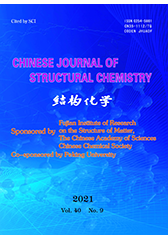Three Novel Luminescent Zinc(II) Compounds Constructed by Employing Mixed-ligand Strategy
ZHU Kun, YANG Jin-Xia, QIN Ye-Yan and YAO Yuan-Gen*
Chin. J. Struct. Chem. 2021, 40, 1152-1160 DOI: 10.14102/j.cnki.0254-5861.2011-3129
September 15, 2021
zinc(II) compounds, hydrothermal reaction, aliphatic dicarboxylates, mix-ligand, luminescence
ABSTRACT
Three
novel coordination polymers, [Zn(suc)(o-bix)]n (1), [Zn(suc)(m-bix)·H2O]n (2) and [Zn2(suc)2(p-bix)2·4H2O]n (3) (H2suc = succinic acid, o-bix = 1,2-bis(imidazol-1-ylmethyl)-benzene, m-bix = 1,3-bis(imidazol-1-ylmethyl)-benzene, p-bix = 1,4-bis(imidazol-1-ylmethyl)-benzene), have been synthesized
and structurally characterized by elemental analysis, IR spectroscopy,
thermogravimetric analysis, powder X-ray diffraction, and single-crystal X-ray
diffraction. These three coordination polymers present various structures
originated from auxiliary N-donor ligands with different configurations.
Compound 1 shows a 2D network with 44-sql topology. Compound 2 exhibits an infinite chain, and the
adjacent chains are extended into a 2D sheet by π-π stacking interactions. Changing the conformation of the N-donor ligand leads to 3 featuring a 3D framework with a novel 4-connected (65·8)
topology. In addition, the solid-state photoluminescent properties of compounds 1~3 are investigated.








